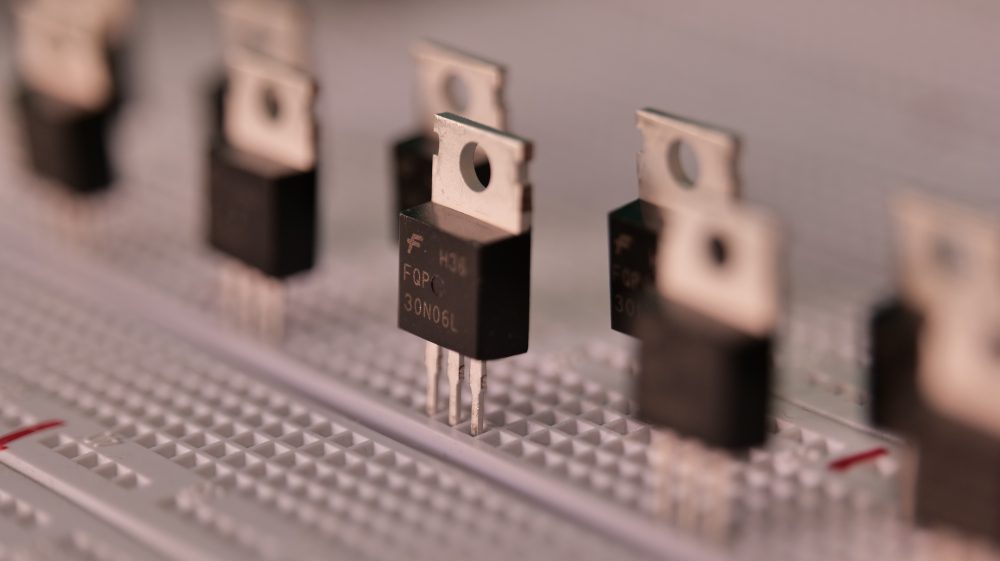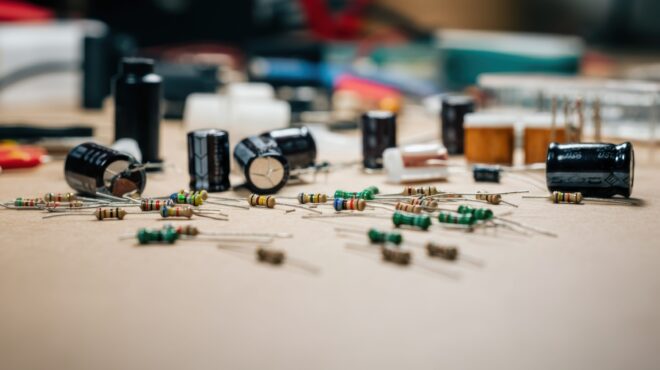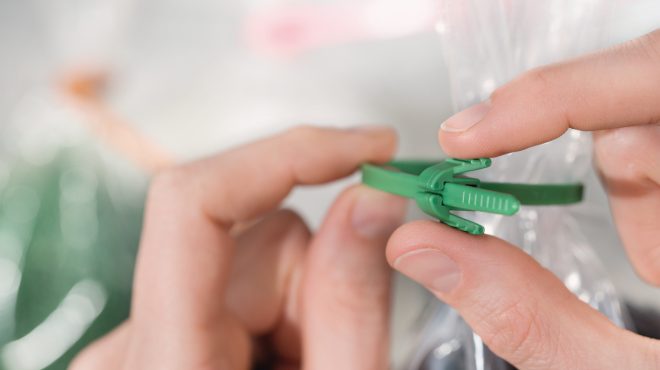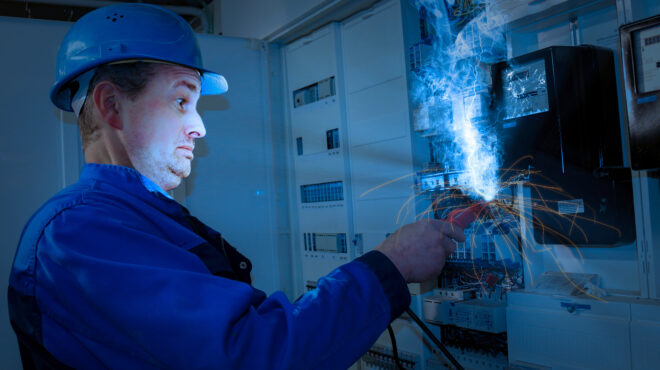
Smallest Electronic Components: Transistors & Diodes
Numerous transistors and diodes are built into industrial applications and electronic components. Even the tiny microprocessor of a smartphone contains millions to billions of these miniature electronic components. A diode or transistor can be used to control or regulate currents. You can find out all about the structure of transistors, their characteristic properties and areas of application in the magazine article from Bürklin Elektronik.
What are transistors?
A transistor is an electrical semiconductor component that serves to switch, regulate or amplify currents. According to the respective circuit type, the transistor can be used like a resistor. The currents can be individually “controlled” or “regulated”. In addition, current can be slowed down or the current flow can be completely interrupted – in this case, the transistor acts as a switch.
The current flow can also be increased by a transistor, in which case the electronic component is used as an amplifier. Field-effect transistors (FET) or bipolar transistors (BJT) are often installed in electronic devices.
What is a transistor used for?
At its core, a transistor is a current- or voltage-controlled resistor that is often made of silicon. Inside there are electrons and so called holes (defect electrons) between which the particles can move. By the movement of the particles, current can be controlled (= amplified, switched or regulated). FETs are voltage controlled, while BJTs are current controlled. This means that the resistance value of the transistor can be changed by the current flow or the application of a voltage. This allows currents in a circuit or an electrical device to be regulated, switched or amplified – without a mechanical process (such as with a rocker or toggle switch).
Which transistors are there?
There are two basic forms of transistors: voltage-controlled and current-controlled. They differ on the one hand in the control of the resistance value (by the voltage or current quantity) and on the other hand in the type of charge carriers. In BJT (bipolar transistors) they are electrons and holes (= defect electrons), in FET (field effect transistors) they are electrons or holes.
Definition of so-called holes: In a transistor there are negative charge carriers (= electrons) and positive charge carriers (= defect electrons). The latter, also called “holes”, are unoccupied states in the valence band . These move by generation and recombination within the crystal structure of the semiconductor.
Where are transistors used?
Transistors are built into almost all electronic devices. Whether in smartphones, computers, chargers, or networks, they can be used to switch and control the operation of lamps, relays, or motors, and are basically used to control currents or voltages.
Bipolar transistors
Bipolar transistors (BJT) consist of three doped semiconductor layers. The addition NPN or PNP gives information about the doping. For example, an NPN transistor is constructed as follows: one n-doped and one p-doped layer and then another n-doped layer. In both types of construction (NPN and PNP) there are three terminals, the base (= B), the collector (= C) and the emitter (= E).
Good to know: Doping is the intentional introduction of foreign atoms into the crystal structure of a semiconductor. This serves to modulate the electrical conductivity. Depending on the number of outer electrons, the semiconductor is then called p-doped or n-doped.
By using a bipolar transistor as an amplifier, the base current can be increased many times over. In concrete terms, this means that the collector current IC (= output current) is 20 times to 10,000 times greater than the input current IB.
NPN transistor
NPN transistors are suitable for two applications. They are used either as on/off switches or as amplifiers in circuits. NPN transistors as amplifiers: you pass a small amount of current through the transistor and get a larger amount. NPN transistors are semiconductors, and these can be doped.
All NPN transistors have three connections: base, collector and emitter. From the base the current flows to the emitter (= input). From the collector to the emitter flows the larger collector current (= output). The p-doped base is only lightly doped, while the emitter layer is heavily n-doped due to the high electron count.
Through this process, a small current input can be strengthened, so that a larger output current is achieved.
PNP transistor
Like the NPN transistor, the PNP transistor consists of three layers: a p-doped collector layer, a slightly n-doped base layer and a heavily p-doped emitter layer. Between collector and emitter is the voltage UCE and between base and emitter is the voltage UBE.
From the emitter to the base flows the small current IB (= input) and from the emitter to the collector the larger current IC (= output). The free holes (defect electrons) move from the emitter to the collector layer. Current can flow, and for this it needs the low voltage UBE.
The PNP transistor can also be used as a switch. This means: The current flow can be completely activated or deactivated.
Standard types of bipolar transistors for industry
| Typ | NPN/PNP | Gehäuse | Ptot/W | UCE/V | IC/A | B (ß) | fG/MHz |
|---|---|---|---|---|---|---|---|
| BC107B | NPN | TO-18 | 0,3 | 45 | 0,1 | 200 – 450 | 300 |
| BC140-6 | NPN | TO-39 | 3,7 | 40 | 1 | 40 – 100 | 50 |
| BC140-10 | NPN | TO-39 | 3,7 | 40 | 1 | 63 – 160 | 50 |
| BC140-16 | NPN | TO-39 | 3,7 | 40 | 1 | 100 – 250 | 50 |
| BC547A | NPN | SOT-54 | 0,5 | 45 | 0,1 | 110 – 220 | 300 |
| BC547B | NPN | SOT-54 | 0,5 | 45 | 0,1 | 200 – 450 | 300 |
| BC547C | NPN | SOT-54 | 0,5 | 45 | 0,1 | 420 – 800 | 300 |
| BC557A | PNP | SOT-54 | 0,5 | 45 | 0,1 | 125 – 250 | 150 |
| 2N3055 | NPN | TO-3 | 115 | 50 | 15 | 20 – 70 | 0,8 |
Field effect transistors
Field effect transistors are voltage controlled transistors in which only one type of charge (electrons or holes) is involved. The most common type of these transistors are MOSFET.
MOSFET
MOSFET stands for metal-oxide-semiconductor field-effect transistor, where S means semiconductor. The MOSFET consists of a basic substrate, and depending on how this is doped, a distinction is made between N-MOS and P-MOS.
Example N-MOS: The basic substrate is p-doped and two n-doped zones are inserted. This part of the electrical component is circumscribed in total by the letter S (= semiconductor) in the word MOSFET. Two different layers are deposited on the center of the semiconductor block. The upper layer is made of metal (= M), underneath there is an oxide layer (= O).
As with bipolar transistors, there are three terminals for integrating the transistor into the circuit: the source terminal (= S), the gate terminal (= G) and the drain terminal (= D).
High-performance transistors for industry
The construction of transistors is based in most cases on the element silicon. The electronic components serve in circuits as contactless switches, regulators, impedance converters (= resistance converters) as well as amplifiers. These functions are possible because a transistor can influence large load currents with small control currents.
In addition, no mechanical component is required for activation or deactivation, which means that the electrical component is subject to little or no mechanical wear. These are ideal conditions for integration in industrial systems, as maintenance and repair are reduced in this area. Transistor technology is also used in integrated circuits ICs (= Integrated Circuits). New types of processors and microcontrollers have several billion transistor elements.
The semiconductors switch electrical currents on or off within the processor to enable computing operations to be carried out. Transistors are also used in other applications such as power electronics, networks, communications technology, automotive or medical technology, and aerospace engineering.
Transistors for industrial applications
- Switching diode Si: 100 volts, 0.3 amps, 8 nano-seconds MiniMELF (LL 4148-GS08 series)
- LED THT (through-hole technology): 569 nanometers, 20 milliamps, 2.2 volts (L-53SGC series)
- AF Schottky diode: 70 volts, 70 milliamps (BAS70 series)
- Small-signal Schottky diode: 30 volts, 200 milliamps (BAS85, 115 series)
Transistors at Bürklin Elektronik
In our online store you will find high-quality transistors (FET or BJT) as well as diodes and semiconductors for a wide variety of applications. Whether products for medical technology, aircraft or aerospace technology, for networks as well as various electronic devices: At Bürklin Elektronik your individual needs are covered! Continue to the online store!
In the online magazine you will find further interesting articles on many topics and product areas from technology, electronics and the associated fields of application. Read the Bürklin Elektronik online magazine!


